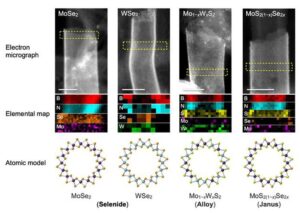Move over carbon, the nanotube family just got bigger

Boron-nitride nanotubes can template the growth of TMD nanotubes both inside and outside the tube. These can be directly observed by transmission electron microscopy (right).
Credit: Tokyo Metropolitan University
Transition metal dichalcogenide nanotubes promise leap beyond carbon nanotubes.
Researchers from Tokyo Metropolitan University have engineered a range of new single-walled transition metal dichalcogenide (TMD) nanotubes with different compositions, chirality, and diameters by templating off boron-nitride nanotubes. They also realized ultra-thin nanotubes grown inside the template, and successfully tailored compositions to create a family of new nanotubes. The ability to synthesize a diverse range of structures offers unique insights into their growth mechanism and novel optical properties.
The carbon nanotube is a wonder of nanotechnology. Made by rolling up an atomically thin sheet of carbon atoms, it has exceptional mechanical strength and electrical conductivity amongst a range of other exotic optoelectronic properties, with potential applications in semiconductors beyond the silicon age.
The key features of carbon nanotubes come from subtle aspects of their structure. For example, like a piece of paper rolled up at an angle, nanotubes often have a chirality, a “handedness” in their structure that makes them different from their mirror image. That is also why scientists are looking ahead to materials beyond carbon, which might enable a wider range of structures. One spotlight is on transition metal dichalcogenide (TMD) compounds, made of transition metals and Group 16 elements. Not only is there a whole family of them, TMDs have features which are not seen in carbon nanotubes, such as superconductivity and photovoltaic properties, where exposure to light generates a voltage or current.
To get to grips with the full potential of TMDs, however, scientists need to be able to make single-walled nanotubes in a variety of compositions, diameters, and chirality in a way that lets us study their individual properties. This has proven challenging: TMD nanotubes usually form in concentric multi-walled structures, where each layer might have different chirality. This makes it tricky to find out, for example, what kind of chirality gives rise to specific properties.

Credit: Tokyo Metropolitan University
Now, a team led by Assistant Professor Yusuke Nakanishi from Tokyo Metropolitan University has come up with a way to do just that. By using boron-nitride nanotubes as a template, they could successfully grow a range of single-walled TMD nanotubes by adding the required elements through exposure to vapor. In previous work, they made single-walled molybdenum sulfide nanotubes. On looking at individual nanotubes in more detail, they have now distinguished a whole plethora of single-walled tubes of different diameters and chirality. Specifically, they measured the “chiral angles” of individual tubes which, taken together with their diameters, determine unique chiral structures. They discovered, for the first time, that the chiral angles of their nanotubes were randomly distributed: this means they have access to the whole range of possible angles, promising new insights into the relationship between chirality and electronic states, a key unsolved question in the field. There were also ultra-thin tubes only a few nanometers across grown inside the template, not outside, a unique platform for observing quantum mechanical effects.
By tweaking their recipe, the team has now also succeeded in switching both the metal and the chalcogen, making molybdenum selenide, tungsten selenide, and molybdenum tungsten sulfide alloy nanotubes. They even made nanotubes with one element on the outside, another on the inside, “Janus”-type nanotubes named after the two-faced god of Roman mythology. The team’s diverse new entries into the nanotube family promise bold new strides in not only our understanding of TMD nanotubes, but how exotic properties arise from their structures.
This work was supported by JSPS KAKENHI Grants (Grant Numbers JP23H01807, JP20H02572, JP21H05232, JP21H05234, JP22K04886, JP22H05468, JP22H01911, JP22H02573, JP21H05017, JP22H05469, JP23H00259, JP23K13635, JP23H00097, JP22H05441, JP21H05235, JPJSJRP20221202), the JST CREST Program (Grant Numbers JPMJCR17I5 and JPMJCR20B1) and the JST FOREST Program (Grant Number JPMJFR213X).
Journal: Advanced Materials
DOI: 10.1002/adma.202306631
Article Title: Structural Diversity of Single-Walled Transition Metal Dichalcogenide Nanotubes Grown via Template Reaction
Article Publication Date: 5-Oct-2023
Media Contact
GO TOTSUKAWA
Tokyo Metropolitan University
totsukawa-go@jmj.tmu.ac.jp
Office: 81-426-772-829
Original Source
All latest news from the category: Materials Sciences
Materials management deals with the research, development, manufacturing and processing of raw and industrial materials. Key aspects here are biological and medical issues, which play an increasingly important role in this field.
innovations-report offers in-depth articles related to the development and application of materials and the structure and properties of new materials.
Newest articles

Molecular gardening: New enzymes discovered for protein modification pruning
How deubiquitinases USP53 and USP54 cleave long polyubiquitin chains and how the former is linked to liver disease in children. Deubiquitinases (DUBs) are enzymes used by cells to trim protein…

Machine learning accelerates catalyst discovery
Conceptual blueprint to analyze experimental catalyst data. Machine learning (ML) models have recently become popular in the field of heterogeneous catalyst design. The inherent complexity of the interactions between catalyst…

More efficient car designs with AI
8,000 open source models for sustainable mobility. Designing new cars is expensive and time consuming. As a result, manufacturers tend to make only minor changes from one model generation to…



